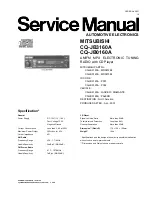
Chapter 2
MAINTENANCE
1.0
Introduction
This chapter of the manual describes:
■
preventive maintenance
■
safe handling of CMOS devices
■
repair procedures and techniques
2.0
Preventive Maintenance
The radios do not require a scheduled preventive maintenance program; however, periodic visual
inspection and cleaning is recommended.
2.1
Inspection
Check that the external surfaces of the radio are clean, and that all external controls and switches
are functional. It is not recommended to inspect the interior electronic circuitry.
2.2
Cleaning
The following procedures describe the recommended cleaning agents and the methods to be
used when cleaning the external and internal surfaces of the radio. External surfaces include the
front cover, housing assembly, and battery case. These surfaces should be cleaned whenever a
periodic visual inspection reveals the presence of smudges, grease, and/or grime.
The only recommended agent for cleaning the external radio surfaces is a 0.5% solution of a mild
dishwashing detergent in water. The only factory recommended liquid for cleaning the printed
circuit boards and their components is isopropyl alcohol (70% by volume).
1.
Cleaning External Plastic Surfaces
The detergent-water solution should be applied sparingly with a stiff, non-metallic, short-
bristled brush to work all loose dirt away from the radio. A soft, absorbent, lintless cloth or
tissue should be used to remove the solution and dry the radio. Make sure that no water
remains entrapped near the connectors, cracks, or crevices.
2.
Cleaning Internal Circuit Boards and Components
Isopropyl alcohol may be applied with a stiff, non-metallic, short-bristled brush to dislodge
embedded or caked materials located in hard-to-reach areas. The brush stroke should
direct the dislodged material out and away from the inside of the radio. Make sure that
controls or tunable components are not soaked with alcohol. Do not use high-pressure
air to hasten the drying process since this could cause the liquid to collect in unwanted
places. Upon completion of the cleaning process, use a soft, absorbent, lintless cloth to
dry the area. Do not brush or apply any isopropyl alcohol to the frame, front cover, or
back cover.
NOTE
Internal surfaces should be cleaned only when the radio is disassembled for servicing or
repair.
CAUTION: The effects of certain chemicals and their vapors can have harmful results on
certain plastics. Aerosol sprays, tuner cleaners, and other chemicals should be avoided.
!
Summary of Contents for CP 140
Page 1: ...Commercial Series CP140 CP160 CP180 Portable Radios Detailed Service Manual 6866550D20 O ...
Page 2: ...ii ...
Page 4: ...iv ...
Page 12: ...viii ...
Page 28: ...iv ...
Page 40: ...1 12 THEORY OF OPERATION ...
Page 48: ...2 8 TROUBLESHOOTING TABLES ...
Page 50: ...3 2 CONTROLLER KEYPAD SCHEMATICS ...
Page 58: ...3 10 Keypad Board Parts List 8466565A01 O ...
Page 62: ...iv ...
Page 66: ...1 4 MODEL CHART AND TECHNICAL SPECIFICATIONS ...
Page 90: ...3 16 TROUBLESHOOTING TABLES ...
Page 92: ...4 2 VHF PCB SCHEMATICS PARTS LISTS ...
Page 108: ...iv ...
Page 112: ...1 4 MODEL CHART AND TECHNICAL SPECIFICATIONS ...
Page 136: ...3 16 TROUBLESHOOTING TABLES ...
Page 138: ...4 2 UHF1 PCB SCHEMATICS PARTS LISTS ...
Page 154: ...iv ...
Page 158: ...1 4 MODEL CHART AND TECHNICAL SPECIFICATIONS ...
Page 182: ...3 16 TROUBLESHOOTING TABLES ...
Page 184: ...4 2 UHF2 PCB SCHEMATICS PARTS LISTS ...
Page 200: ...iv ...
Page 204: ...1 4 MODEL CHART AND TECHNICAL SPECIFICATIONS ...
Page 228: ...3 16 TROUBLESHOOTING TABLES ...
















































